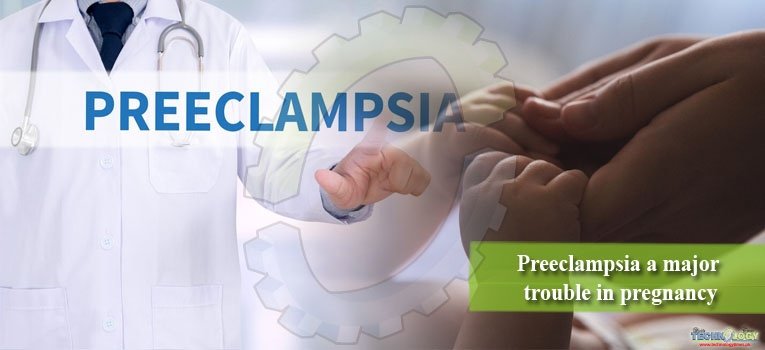A complication in pregnancy associated by gestational hypertension and proteinuria is called preeclampsia. Preeclampsia not only affects the mother but infant as well.

Gestational hypertension as the name implies is a high blood pressure condition in pregnancy and it occurs in almost 6% of all pregnancies and proteinuria is the condition when protein is release in urine.
The hypertensive disorder of pregnancy which includes hypertension that occurs before pregnancy, gestational and chronic hypertension occurs during pregnancy. A condition which includes gestational hypertension and along with that onset or proteinuria then the disorder is classified as Preeclampsia and if it is not accompanied by proteinuria then it is called transient hypertension of pregnancy. In case a woman which is already suffering from chronic hypertension also gets symptoms of preeclampsia then this condition is termed as superimposed preeclampsia. If seizures occur in a woman who is already suffering from preeclampsia then it is termed as eclampsia.
It is proposed that there are two stages in which preeclampsia occur. This 2 stage model has been design to clear the concepts and pathophysiology of preeclampsia. Stage 1 includes the root cause that is the basics and it is reduction in placental perfusion. Stage 2 which is can also be labelled as multisystemic maternal syndrome of preeclampsia.
Preeclampsia is also divided into mild, moderate and severe preeclampsia along with it is also divided as late onset and early onset preeclampsia. These two early and late preeclampsia both have different etiologies and also have different types of clinical symptoms.
HISTORY
Hippocrates was the first who noticed about preeclampsia-eclampsia in around 400 BC. Headache along with heaviness and convulsion during pregnancy was considered bad symptoms by Hippocrates. These clinical symptoms were the earliest one which as associated with unhealthy pregnancy. As these were the earliest signs of disease the only remedy present of use at that time was to focus on the body fluids and try to balance the body fluids by special diets, blood-letting and purging.
Until 20th century work on preeclampsia and eclampsia remained limited however careful and thorough research remained continue by doctors and research which ended as a separate field of obstetric medicine. In 1800’s when the causes of the disease were towards theory of toxins, but the treatment for female patients with headache along with edema only includes that those were admitted to lying-in hospitals where bleeding and purging was still the only prescribed treatments to prevent convulsions and to purge the body of overabundant toxins.
11.1% of deaths related to pregnancy was due to hypersensitive disorders of pregnancies which majorly includes preeclampsia in the United stated from 2006-2007 stated by Centers for Disease Control and Prevention (CDC). CDC data for 2009 shows that gestational hypertensions which also includes preeclampsia resulted in 41.2 live births out of 1000 which means more than 4% of total pregnancies.
SIGNS AND SYMPTOMS
High blood pressure, increased level of protein in urine, face swelling and hand swelling all are signs of Preeclampsia. Women with preeclampsia are mostly asymptomatic but the data and the studies done in United States stated that some may also experience some systemic symptoms which includes headaches, seeing spots and pain in abdomen. Conditions of preeclampsia also include placental interference, as placenta acts as a connection or link between the mother and fetus thus restricting the growth of the baby.
The only way out or cure for gestational preeclampsia is to deliver the fetus. Some doctors also suggest to prolong the pregnancy so the fetus gets more time to get mature. In this case the doctors need to monitor the mother and fetus all the time to make sure that there are no dangerous signs or if they get any so they can deliver the baby immediately.